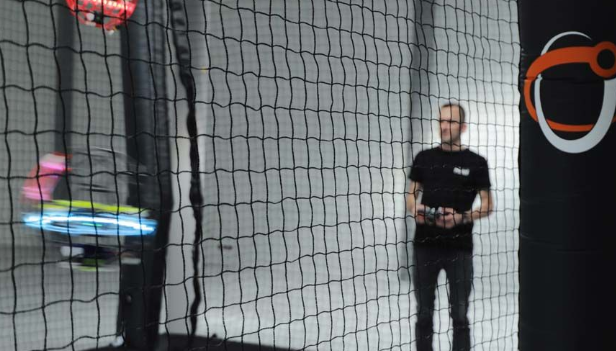Drone Soccer Looks Like Robot Quidditch. Here’s How Educators Are Using It
Drone soccer has taken off across the globe and helps students develop career-ready STEM skills.

David Roberts, president of U.S. Drone Soccer, smiles when I tell him that after watching YouTube videos of drone soccer matches, I think of it as, “robot Quidditch.”
“We know that people have begun to understand how the game plays when they compare it to Quidditch,” Roberts says.
The high-tech aerial sport can now be found in 28 states across the country. Drone soccer involves student-piloted drones squaring off against one another in an enclosed drone arena. The sport supports a variety of STEM skills in students and helps prepare them for potential future careers in the aeronautics industry.
Here’s everything you need to know about drone soccer.
What Is Drone Soccer?
Drone soccer was invented in 2016 by researchers and drone enthusiasts at the CAMTIC Institute of Technology, based in Jeonju, South Korea. The sport is now played across the globe, and has grown exponentially in the U.S. over the past two and a half years -- ever since the U.S. Drone Soccer organization, which promotes it, started programs at four schools in Colorado.
“Now we're at over 240 schools across the United States,” Roberts says.
The game looks like a science fiction battle. It is played indoors or outdoors within a “drone arena” that is about 20m x 10m. The matches consist of three sets. Students on each team pilot drones that fly about 3 meters off of the ground. The “striker” is the only player on each team that can score. The striker does this by flying their drone through a circular goal post placed 3 meters to 3.5 meters off the ground. The other players help their striker score and try to prevent the opposing team’s striker from scoring.
Tools and ideas to transform education. Sign up below.
What Are Some Skills Drone Soccer Teaches Children?
Dr. Robert Mayben uses drone soccer with educators and students as part of his role as a technology in motion specialist at The University of Alabama/University of West Alabama Inservice Center, which provides professional development opportunities for educators within 13 school districts in Alabama.
“One of the best parts about drone soccer is that it's fun,” he says. “I'm not having to teach Excel or Google Sheets, or something like that. I'm able to do something that's tangible and fun for the kids.”
But although the fast-paced competition is fun, it offers more than that. “It teaches them not only skills in flying but collaboration and engineering,” Mayben says.
Those types of lessons are what U.S. Drone Soccer is all about, Roberts says. “Our mission is to inspire students to pursue education and careers in aerospace and science by providing a hierarchy of competitions and events that highlight student skills and engineering and aviation teamwork and leadership,” he says.
How Accessible Is Drone Soccer?
The sport sounds expensive at first glance but U.S. Drone Soccer and its industry partners are dedicated to making it more accessible. Michelin Inflatable Solutions, a subsidiary of Michelin, has partnered with U.S. Drone Soccer to provide educators across the U.S. inflatable drone arenas. These are easy to transport and lightweight. Mayben utilizes one of these portable drone arenas for his demonstrations with drone soccer in Alabama.
Anne-Frédérique Salit, CEO Of Michelin Inflatable Solutions, says Michelin partnered with U.S. Drone Soccer because the inflatable drone soccer arenas support diversity and inclusivity in STEM education. “We think that technology is inclusive by nature,” she says. She adds that drone soccer can encourage women and students from any background to get involved with STEM activities.
What If An Educator Wants To Get Their School or District Involved?
DroneSoccer.us has all the resources that educators who want to start a drone soccer program might need, says Roberts. The process will include a variety of steps, including PD for the educators who are going to lead the project. In addition, leaders of a school's drone soccer program need to find a space to fit the inflatable drone arena, but that isn’t particularly difficult in most school settings.
“It’s going to fit in any school gymnasium or multipurpose room,” Roberts says.
While going through the process, educators should also keep their eyes on the prize, Mayben adds. Remember: Drone soccer is a practical sport and activity for kids to get involved with, but it can lead to various STEM-related opportunities.
“There are so many jobs becoming available for drones,” he says. “In drone soccer, they can get that experience of flying the drone. They can go through and continue through the curriculum and get their drone license, and they can walk out of high school career-ready."
Erik Ofgang is a Tech & Learning contributor. A journalist, author and educator, his work has appeared in The New York Times, the Washington Post, the Smithsonian, The Atlantic, and Associated Press. He currently teaches at Western Connecticut State University’s MFA program. While a staff writer at Connecticut Magazine he won a Society of Professional Journalism Award for his education reporting. He is interested in how humans learn and how technology can make that more effective.

